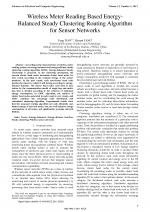| 2/2011 - 2 |
Wireless Meter Reading Based Energy-Balanced Steady Clustering Routing Algorithm for Sensor NetworksTIAN, Y. |
| Extra paper information in |
| Click to see author's profile in |
| Download PDF |
Author keywords
energy-balanced, energy-distance function, steady clustering, wireless sensor networks
References keywords
networks(18), sensor(15), energy(8), distributed(8), data(7), computing(5), parallel(4)
Blue keywords are present in both the references section and the paper title.
About this article
Date of Publication: 2011-05-30
Volume 11, Issue 2, Year 2011, On page(s): 9 - 14
ISSN: 1582-7445, e-ISSN: 1844-7600
Digital Object Identifier: 10.4316/AECE.2011.02002
Web of Science Accession Number: 000293840500002
SCOPUS ID: 79958824204
Abstract
According to the characteristics of wireless meter reading system, an energy-balanced and energy-efficient steady clustering routing algorithm (EBSC, Energy-Balanced Steady Clustering) is proposed. In the clustering mechanism, the current cluster head nodes determine cluster head nodes for next round according to the residual energy of the cluster members. In the next round, each non-cluster head node decides the cluster to which it will belong according to energy-distance function. The cluster head nodes send data to base station by the communication model of single hop and multi-hop that is decided according to the criterion of minimum energy consumption. In EBSC algorithm, the number of cluster head nodes generated in each round is very steady, and EBSC combines the advantage both distributed and centralized clustering algorithm. Experimental results show that the proposed routing algorithm not only efficiently uses limited energy of network nodes, but also well balances energy consumption of all nodes, and significantly prolongs network lifetime. |
| References | | | Cited By |
Web of Science® Times Cited: 4 [View]
View record in Web of Science® [View]
View Related Records® [View]
Updated today
SCOPUS® Times Cited: 8
View record in SCOPUS® [Free preview]
View citations in SCOPUS® [Free preview]
[1] A Real-Time Big Data Gathering Algorithm Based on Indoor Wireless Sensor Networks for Risk Analysis of Industrial Operations, Ding, Xuejun, Tian, Yong, Yu, Yan, IEEE Transactions on Industrial Informatics, ISSN 1551-3203, Issue 3, Volume 12, 2016.
Digital Object Identifier: 10.1109/TII.2015.2436337 [CrossRef]
[2] Energy-efficient clustering method for wireless sensor networks using modified gravitational search algorithm, Ebrahimi Mood, Sepehr, Javidi, Mohammad Masoud, Evolving Systems, ISSN 1868-6478, Issue 4, Volume 11, 2020.
Digital Object Identifier: 10.1007/s12530-019-09264-x [CrossRef]
[3] Third-Order Channel Propagation Model-Based Indoor Adaptive Localization Algorithm for Wireless Sensor Networks, Tian, Yong, Tang, Zhenan, Yu, Yan, IEEE Antennas and Wireless Propagation Letters, ISSN 1536-1225, Issue , 2013.
Digital Object Identifier: 10.1109/LAWP.2013.2293578 [CrossRef]
[4] THWSN: Enhanced Energy-Efficient Clustering Approach for Three-Tier Heterogeneous Wireless Sensor Networks, Kumar, Nitin, Rani, Preeti, Kumar, Vinod, Athawale, Shashikant V., Koundal, Deepika, IEEE Sensors Journal, ISSN 1530-437X, Issue 20, Volume 22, 2022.
Digital Object Identifier: 10.1109/JSEN.2022.3200597 [CrossRef]
[5] Wireless sensor location systems comparative performances evaluation, Coca, Eugen, Popa, Valentin, 2012 IEEE 18th International Symposium for Design and Technology in Electronic Packaging (SIITME), ISBN 978-1-4673-4760-0, 2012.
Digital Object Identifier: 10.1109/SIITME.2012.6384398 [CrossRef]
Disclaimer: All information displayed above was retrieved by using remote connections to respective databases. For the best user experience, we update all data by using background processes, and use caches in order to reduce the load on the servers we retrieve the information from. As we have no control on the availability of the database servers and sometimes the Internet connectivity may be affected, we do not guarantee the information is correct or complete. For the most accurate data, please always consult the database sites directly. Some external links require authentication or an institutional subscription.
Web of Science® is a registered trademark of Clarivate Analytics, Scopus® is a registered trademark of Elsevier B.V., other product names, company names, brand names, trademarks and logos are the property of their respective owners.
Faculty of Electrical Engineering and Computer Science
Stefan cel Mare University of Suceava, Romania
All rights reserved: Advances in Electrical and Computer Engineering is a registered trademark of the Stefan cel Mare University of Suceava. No part of this publication may be reproduced, stored in a retrieval system, photocopied, recorded or archived, without the written permission from the Editor. When authors submit their papers for publication, they agree that the copyright for their article be transferred to the Faculty of Electrical Engineering and Computer Science, Stefan cel Mare University of Suceava, Romania, if and only if the articles are accepted for publication. The copyright covers the exclusive rights to reproduce and distribute the article, including reprints and translations.
Permission for other use: The copyright owner's consent does not extend to copying for general distribution, for promotion, for creating new works, or for resale. Specific written permission must be obtained from the Editor for such copying. Direct linking to files hosted on this website is strictly prohibited.
Disclaimer: Whilst every effort is made by the publishers and editorial board to see that no inaccurate or misleading data, opinions or statements appear in this journal, they wish to make it clear that all information and opinions formulated in the articles, as well as linguistic accuracy, are the sole responsibility of the author.



